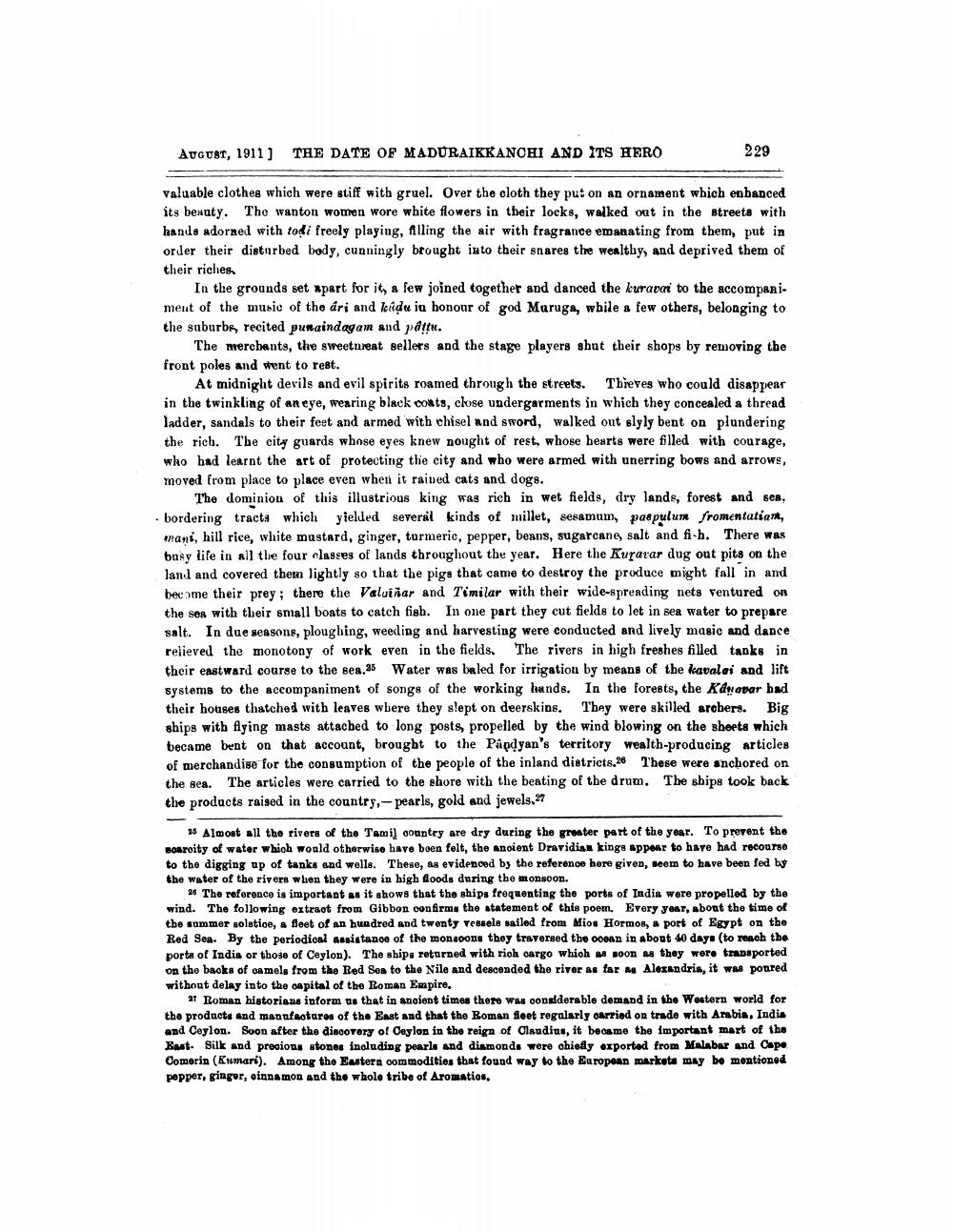________________
August, 1911) THE DATE OF MADURAIKKANCHI AND ITS HERO
229
valuable clothes which were stiff with gruel. Over the cloth they put on an ornament which enhanced its beauty. The wanton women wore white flowers in their locks, walked out in the streets with hands adorned with todi freely playing, filling the air with fragrance emanating from them, put in order their disturbed body, cunningly brought into their snares the wealthy, and deprived them of their riches
In the grounds set apart for it, a few joined together and danced the kuravar to the accompani. ment of the music of the ari and kadu in honour of god Maruga, while a few others, belonging to the suburbs, recited punaindagam and pattu.
The merchants, the sweetnreat sellers and the stage players shut their shops by removing the front poles and went to rest.
At midnight devils and evil spirits roamed through the streets. Thieves who could disappear in the twinkling of an eye, wearing black costs, close undergarments in which they concealed a thread ladder, sandals to their feet and armed with chisel and sword, walked out slyly bent on plundering the rich. The city guards whose eyes knew nought of rest, whose hearts were filled with courage, who had learnt the art of protecting the city and who were armed with unerring bows and arrows, moved from place to place even when it rained cats and dogs.
The dominion of this illustrious king was rich in wet fields, dry lands, forest and sea, · bordering tracts which yielded several kinds of millet, sesamum, paspulum fromentatiara, mani, hill rice, white mustard, ginger, turmeric, pepper, beans, sugarcane, salt and fi-h. There was basy life in all the four classes of lands throughout the year. Here the Kurarar dug out pits on the land and covered them lightly so that the pigs that came to destroy the produce might fall in and become their prey; there the Valuiñar and Timilar with their wide-spreading nets ventured on the sex with their small boats to catch fish. In one part they cut fields to let in sea water to prepare salt. In due seasons, ploughing, weeding and harvesting were conducted and lively music and dance relieved the monotony of work even in the fields. The rivers in high freshes filled tanks in their eastward course to the sea.35 Water was baled for irrigation by means of the kavalai and lift systems to the accompaniment of songs of the working hands. In the forests, the Kdyavar bad their houses thatched with leaves wbere they slept on deerskins. They were skilled archers. Big ships with flying masts attached to long posts, propelled by the wind blowing on the sheets which became bent on that account, brought to the Pâpdyan's territory wealth-producing articles of merchandise for the consumption of the people of the inland districts.28 These were anchored on the sea. The articles were carried to the shore with the beating of the drum. The ships took back the products raised in the country, -pearls, gold and jewels.27
25 Almost all the rivers of the Tamil country are dry during the greater part of the year. To prevent the Boaroity of water which would otherwise have boen felt, the ancient Dravidian kings appear to have had recours to the digging up of tanks and wells. These, as evidenced by the reference here given, seem to have been fed by the water of the rivers when they were in high foods during the monsoon.
26 The reference is important as it shows that the ships frequenting the ports of India were propelled by the wind. The following extract from Gibbon confirms the statement of this poem. Every year, about the time of the summer solstioe, a fleet of an hundred and twenty vessels sailed from Mios Hormos, a port of Egypt on the Red Sea. By the periodioal assistance of the monsoons they traversed the ocean in about 40 day. (to reach the porta of India or those of Ceylon). The ships returned with rich cargo which as soon as they were transported on the backs of oamels from the Red Sea to the Nile and descended the river as far Me Alexandria, it was poured without delay into the oapital of the Roman Empire.
27 Roman historians inform us that in ancient times there was considerable demand in the Western world for the products and manufactures of the East and that the Roman fleet regularly carried on trade with Arabia, India and Ceylon. Soon after the discovery of Ceylon in the reign of Claudias, it became the important mart of the East. Silk and precious stones including pearls and diamonds were chiedy exported from Malabar and Cape Comerin (Kumari). Among the Eastern commodities that found way to the European marketa may be mentioned pepper, ginger, innamon and the whole tribe of Aromatios.




